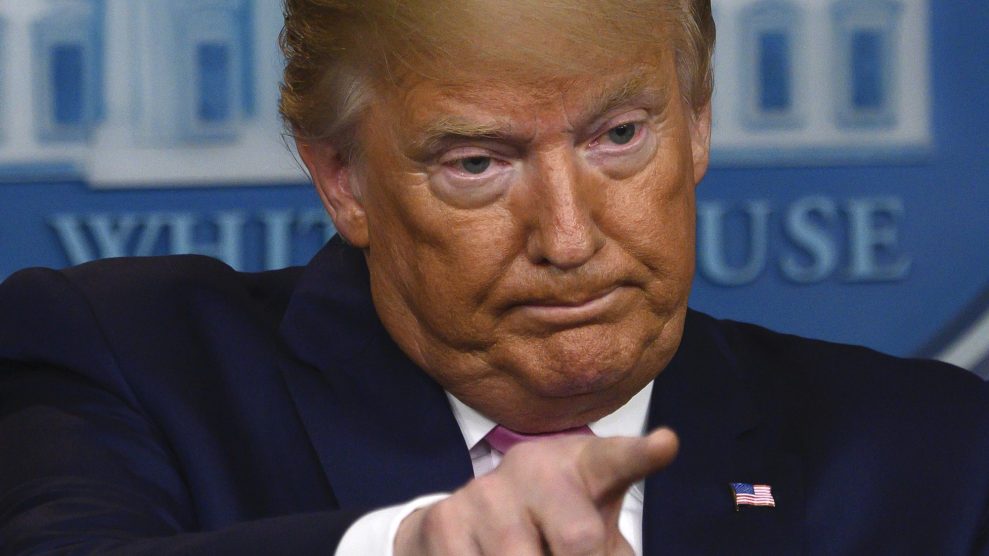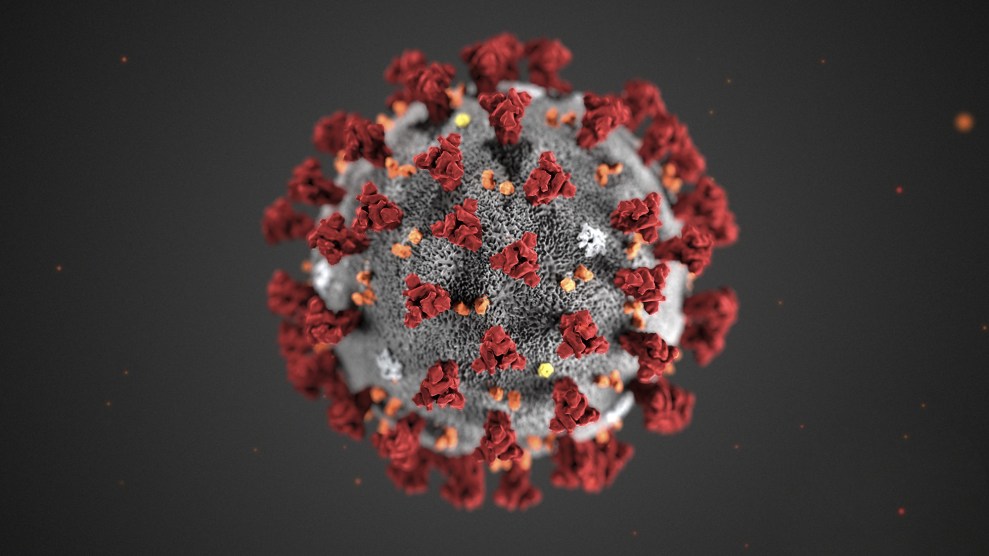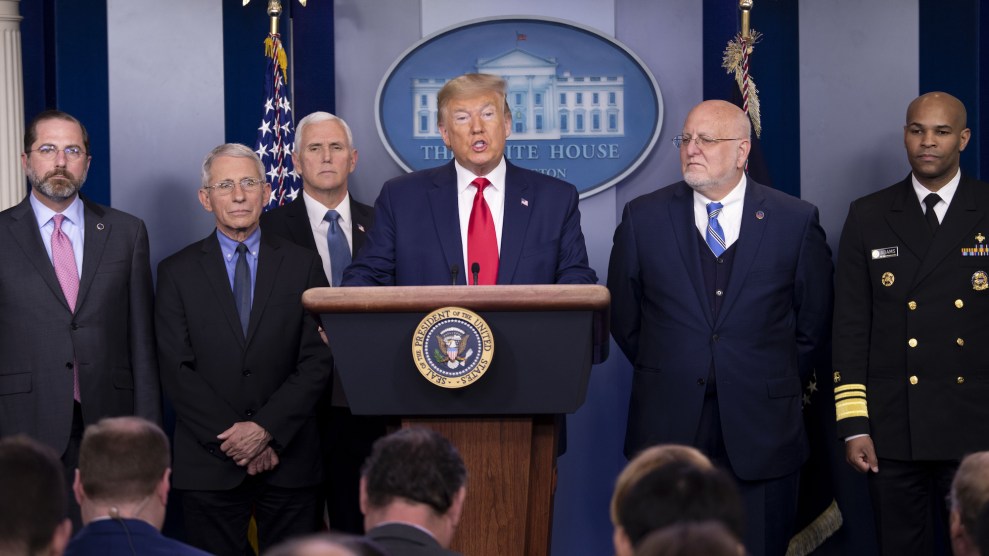
Andrew Caballero-Reynolds/Getty
“We’re very, very ready for this, for anything,” President Trump said at a White House press briefing on the coronavirus last Wednesday. Despite the president’s reassurance, public health experts warn that our response is already woefully deficient. With the Trump administration failing to send out enough testing kits and multiple White House officials spreading misinformation about the virus, it’s hard not to be concerned about their ability to handle the threat of a global pandemic.
Here are some of the greatest hits of the Trump administration’s bungled coronavirus responses—so far:
- Trump picked Vice President Mike Pence—well known for allowing an outbreak of HIV to rapidly spread in Indiana during his time as governor—to head the government’s coronavirus task force. As governor, Pence initially refused to allow clean-needle exchange programs, which experts argued were necessary to prevent further outbreaks of HIV. He also spearheaded funding cuts to Planned Parenthood, which led to the closing of the last HIV testing facility in a county at the center of the outbreak.
- Last month, in its 2021 budget, the Trump administration announced proposed cuts that would reduce CDC funding by 16 percent and slash $3 billion for global health programs.
- In 2018, the National Security Council’s global pandemic director left his post abruptly; then his entire team was disbanded by former national security adviser John Bolton. The Trump administration has yet to refill any of those positions, leaving huge vulnerabilities in our global pandemic preparedness.
- In press conferences and tweets, Trump has been downplaying the severity of the coronavirus. In remarks he made on February 26, he claimed that the number of cases was declining in the United States (the CDC says it’s highly likely it will continue to spread); he claimed that the fatality rate for coronavirus was lower than the flu (it isn’t), and a vaccine was coming quickly (the director of the National Institute of Allergy and Infectious Diseases says it will take at least a year).
- Fewer than 500 people have been tested for the coronavirus in the United States, compared with 13,911 in the UK and 1,126 in the Ontario province of Canada alone as of March 2. Experts blame delays in rolling out the test on account of a faulty component in the original test, which has led to an inadequate supply of tests nationwide. As of Sunday, an unnamed HHS official told Politico that the defects had been resolved. That hasn’t been enough to prevent an HHS investigation into the delayed national response.
- The CDC failed to update testing guidelines to include more people as the disease has spread globally.
- The first instance of coronavirus contracted within the United States took four days to confirm after a delayed response for requests for disease testing from the CDC, according to medical staff at UC Davis Medical Center in California. They blamed the center’s narrow specifications for distributing coronavirus testing kits; the organization allegedly took days to approve the medical center’s request.
- Trump isn’t the only member of his administration spreading misinformation about the coronavirus. Last Tuesday, Trump’s National Economic Council director, Larry Kudlow, told CNBC “we have contained” the virus, despite CDC officials warning that the virus is likely to continue to spread. In a Meet the Press interview Sunday, Vice President and coronavirus head Mike Pence refused to refute Donald Trump Jr.’s claim that Democrats wanted the virus to spread and kill Americans.
- In 2018, the Trump Administration cut 80 percent of CDC funding used to fight global pandemics. The funding support, which went to training local health professionals and bolstering emergency response across 49 countries, was reduced to just 10 nations. China wasn’t included in the revised list.
- Last October, the Trump Administration opted to discontinue a Bush-era program expanded under Obama—called “Predict”—that monitored the threat of animal-born diseases to humans, the possible origin point of the novel coronavirus. The program was behind the discovery of more than 1,000 viruses, including an Ebola strain.
- During a standoff last week on a tarmac in Japan, the State Department pushed to allow 14 coronavirus-infected Americans to board a pair of flights back to the United States. The CDC fought back back, arguing that bringing them back—especially considering the planes carried 300 other passengers who’d tested negative for the disease—would pose an unnecessary risk and more than double the number of infected in the country. In the end, the State Department got its way.
- According to a federal government whistleblower, Department of Health and Human Services personnel have been improperly tending to potentially infected Americans who were in Asia during the outbreak. The whistleblower alleged that the HHS workers, without proper training or protective equipment, operated alongside CDC personnel donned in hazmat suits when seeing patients, and potentially exposed themselves to infection. The whistleblower later indicated that they were unjustly reassigned as retribution for speaking out.
- Without clearance from local health centers, federal health officials planned to fly coronavirus patients from a California air base to a FEMA facility on a decommissioned army base in Anniston, Alabama. The mayor of Anniston, “shocked by the lack of planning,” told HHS officials that the FEMA buildings lacked the medical capability to operate as a quarantine zone. On February 23, the administration dropped the plans. Costa Mesa, California, is also fighting federal plans to transport patients to the city.
- As the crisis unfolded last week, one-third of the coronavirus task force took time off to speak at the Conservative Political Action Convention. The list of CPAC attendees also on the task force included White House chief of staff Mick Mulvaney, Homeland Security Secretary Ken Cuccinelli, Larry Kudlow, director of the White House National Economic Council, HHS secretary Alex Azar, and national security adviser Robert O’Brien. Vice President Pence, who heads the task force, told CPAC attendees that the risk of infection “remains low.”
- Despite reassurances from Trump officials at CPAC and beyond that rumors of the coronavirus have been greatly exaggerated, Cuccinelli indicated during his CPAC speech that the US might tighten borders as a preventative public health measure, despite far fewer cases in Mexico and Canada, where two and 27 cases have been reported, respectively.
- Pence and his office have taken control of all public government statements on the coronavirus, which now go through his press secretary, Katie Miller. Because of this move, the CDC and the National Institutes of Health can no longer share their own research, and a Pence office stamp of approval is required to broadcast independent information.
- When a CDC–distributed coronavirus test kit incorrectly gave a negative result, an infected patient was allowed to leave a San Diego hospital. The patient, who was flown back to the US from China, rejoined the quarantine tank of repatriated citizens for an entire day, before being brought back to the hospital.












